| Pages:
1
2
3
4
5
6 |
caterpillar
Hazard to Others
  
Posts: 472
Registered: 8-1-2012
Member Is Offline
Mood: No Mood
|
|
It was me who misunderstood you. English is not my mother's tongue, as you might guess. I tried to initiate cast TNP using not the double salt, but
Ag2C2, that is much weaker initiator compared with double salt- Ag2C2.AgNO3 (which is less sensitive). Result was very simple- cast TNP was broken for
some pieces, but did not explode. I used mercury fulminate too (and was at nearly killed) but it is at least as dangerous (if no more) than TATP. I
read some info about TATP in one thick russian book (Bagal Lev Ilyitch Chemistry and technology of priming explosives - translation is mine). At this
book only one bad thing was told about TATP- it is very volatile. Double salt is a good choice for amateurs. May be, DDNP is a good primer too and its
preparation doesn't look very complicated. Lead picrate can be used as well, but it is (as I know) relatively weak primer.
Women are more perilous sometimes, than any hi explosive.
|
|
|
Bot0nist
International Hazard
    
Posts: 1559
Registered: 15-2-2011
Location: Right behind you.
Member Is Offline
Mood: Streching my cotyledons.
|
|
Don't be fooled by DDNPs simple looking synthesis that you find in most "black books." The sodium hydroxide and sulfur preparation results in a very
dirty end product that preforms very poorly. There are a few threads here by experience members who had many problems with the synthesis. A source of
relatively pure picramic acid is probably needed.
Your right about Ag2C2.AgNO3 being a great primary, and the ease of it's synthesis and availability of it's precursors put it firmly in the realm of
possibility for most amateurs and hobbyists.
U.T.F.S.E. and learn the joys of autodidacticism!
Don't judge each day only by the harvest you reap, but also by the seeds you sow.
|
|
|
caterpillar
Hazard to Others
  
Posts: 472
Registered: 8-1-2012
Member Is Offline
Mood: No Mood
|
|
Ridiculous, but in my youth I saw picramic acid in a shop ( but I did not know, if this compound was freely available). What about sulphuril nitride?
Bubble at the first chlorine through sulphur in toluene, then dry ammonia gas. It doesn't look very problematic.
Women are more perilous sometimes, than any hi explosive.
|
|
|
Hennig Brand
International Hazard
    
Posts: 1284
Registered: 7-6-2009
Member Is Offline
Mood: No Mood
|
|
The Lead picrates are all fairly weak primaries, the basic lead salt especially though makes a really good flash igniter. For some reason I have had a
lot of trouble making basic lead picrate, but when I did make it was something similar to lead styphnate in explosive properties (a little weaker
though). I was not trying to indicate that basic lead picric would make a good primary to replace TATP for initiating secondaries.
I would like to experiment with DDNP at least once. I should try and track down some picramic acid at some point. I think others including Rosco have
indicated that there are other primaries that would make better use of time and resources. Just for fun though it would be nice to make DDNP once.
I agree Bot0nist that double salts is one of the better ones. Even though it is fairly low powered it has quite good initiating abilities. Have you
ever tried it on something insensitive like TNP though? I think I tried once, but it didn't work out. It is possible though that I didn't use enough,
or that something else wasn't right.
[Edited on 8-5-2012 by Hennig Brand]
"A risk-free world is a very dull world, one from which we are apt to learn little of consequence." -Geerat Vermeij
|
|
|
caterpillar
Hazard to Others
  
Posts: 472
Registered: 8-1-2012
Member Is Offline
Mood: No Mood
|
|
As I told you, I used mercury fulminate, silver carbide (basic one and without success) and TATP. I was quite satisfied with the last one. I have no
intention to discuss its properties here- corresponding tread was closed and I cannot add something interesting. May be, I just was lucky. I prepared
solution of magnesium stiphnate but I did not make lead salt- just at that same time list of restricted reagents had been enlarged and all salts of
nitric acid was included into it. My indolence prevented me from preparing lead nitrate for myself and I found that TATP is very powerful primer. In
that book on primaries I read that lead acetate shouldn't be used for preparation of lead stiphnate, only salt of nitric acid. There are some organic
salts of perchloric acid that are very powerful initiatiors, but they are too damn sensitive.
Women are more perilous sometimes, than any hi explosive.
|
|
|
VladimirLem
Hazard to Others
  
Posts: 204
Registered: 24-5-2010
Member Is Offline
Mood: Have no fear <Vlad> is here.
|
|
guys please...back to topic...
i have read that parafin-wax is soluble in benzine (normal gasoline)...so would it work to mix, lets say 7g of parafin-wax into warm benzine, then
some (93g) HE (PETN/RDX/MHN - all insoluble in benzine) and let the mixture dry...would that work to get a phlegmatized explosive?
and more importand is, is parafine-wax (like that in those tealights with that AL-case) really soluble in benzine?
|
|
|
Maniak
Harmless

Posts: 45
Registered: 26-6-2004
Member Is Offline
Mood: No Mood
|
|
Yeap, this works. It is desired to mix it by some wooden spatula while drying. For sure, you can add some benzine-soluble dye into the wax solution
and then examine the phlegmatized particles under microscope.
|
|
|
Hennig Brand
International Hazard
    
Posts: 1284
Registered: 7-6-2009
Member Is Offline
Mood: No Mood
|
|
My ETN plastique has a measured density of only 1.43 g/cc, however it still packs a mean punch. I have used large marble sized pieces to puch holes in
steel plate up to 1/4 inch thick. A friend and I placed 12g on a 1/4 inch plate and it punched a nice neat hole (well it ripped a scab off the back
actually). I don't have a picture because the piece of plate was given to my friend and I didn't have a camera at the time. He was very impressed and
asked to keep the piece of plate, so I let him have it.
Here are a few pictures from the other day, which show the result of initating 10g of the same plastique on a piece of rectangular structural steel.
The steel is 1/8 inch thick. Notice how it cut out a disc and then drove it through the other side and deep into the ground. I still didn't bother to
dig up the piece, but can tell it went down at least a few inches.
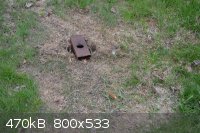 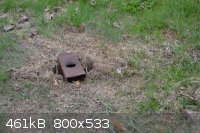 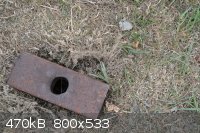 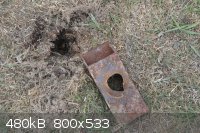
[Edited on 8-5-2012 by Hennig Brand]
"A risk-free world is a very dull world, one from which we are apt to learn little of consequence." -Geerat Vermeij
|
|
|
caterpillar
Hazard to Others
  
Posts: 472
Registered: 8-1-2012
Member Is Offline
Mood: No Mood
|
|
Some words about importance of hi density. In 1905 Russian fleet was destroyed by Japanese one at Chushima channel. One of the reasons of Japanese's
victory was sort of explosive, used in shells. Volume of chamber in a shell is restricted- a shell must withstand tremendous acceleration when gun is
shooting, therefore walls of chamber must be thick enough. Russian used pressed gun cotton, but due to the fibrous nature of NC it could be pressed
only to 1.0 g per cm^3. Japanese, one the other hand, used cast TNP- shimose, that had a density about 1.7 g/cm^3 and their shells of the same caliber
was more powerful.
Women are more perilous sometimes, than any hi explosive.
|
|
|
Hennig Brand
International Hazard
    
Posts: 1284
Registered: 7-6-2009
Member Is Offline
Mood: No Mood
|
|
I have several books and papers with different formulae for calculating the theoretical blast pressure of an explosive. I decided to use the formula
from this explosive engineering paper, there are much more involved ones which have constants specific to the type of explosive, etc. This is a
reasonable approximation however.
From "The Fundamental of Blast Design" by, Wesley L. Bender
P = [(2.16 * 10^-4)(0.45)(pc^2)] / [1+0.0128(p)]
where,
P = detonation pressure in (lbs/in^2)
p = explosive density (lbs/ft^3)
c = detonation velocity (ft/sec)
Using published values for Semtex at 1.43 g/cc, I chose a conservative detonation velocity value of 7200 m/s for my 1.43 g/cc ETN plastique.
Convert Units
p = 1.43 g/cc = 1430 kg/m^3 (since: 1000 mL per liter & 1000 L per m^3 & 1000g per kg)
p = 1430 kg/m^3 * (2.2lb/kg) * [m^3/(3.28ft)^3] = 89.2 lb/ft^3
c = 7200 m/s * 3.28 ft/m = 23 600 ft/s
Using above equation
P = 2.26 Mpsi (million pounds per square inch)
Note:
This formula was meant to give an approximate value of detonation pressure in a borehole, and under strong confinement. It was also meant for
commercial explosives used in rock blasting. It is still probably a reasonable approximation of what the plastique is capable of.
Notice that the detonation velocity of an explosive has much more influence over the detonation pressure than the density does. The formula varies
with the square of the detonation velocity and varies directly with the density.
[Edited on 10-5-2012 by Hennig Brand]
"A risk-free world is a very dull world, one from which we are apt to learn little of consequence." -Geerat Vermeij
|
|
|
Maniak
Harmless

Posts: 45
Registered: 26-6-2004
Member Is Offline
Mood: No Mood
|
|
I'm not sure if I understanded what you wanted to say, but detonation pressure calculated using detonation velocity and density of explosive has
nearly nothing to do with boreholes and confinement. It is a dynamic pressure generated by detonation wave and its calculation is derived from
hydrodynamic model of detonation IIRC.
The pressure in a borehole is another thing - it is a function of volume of explosion gases, temperature, heat of explosion etc.
In another words, you will reach detonation pressure without any confinement, but only in the detonation wave. Presures in the borehole are probably
few orders of magnitude lower..
|
|
|
quicksilver
International Hazard
    
Posts: 1820
Registered: 7-9-2005
Location: Inches from the keyboard....
Member Is Offline
Mood: ~-=SWINGS=-~
|
|
Gentlemen, I think we're going in differing directions here.
According to Rock Blasting & Explosive Engineering (Peerson) we have more than one method. One is "work delivered", another is defining wave
characteristics.
|
|
|
Hennig Brand
International Hazard
    
Posts: 1284
Registered: 7-6-2009
Member Is Offline
Mood: No Mood
|
|
I think quicksilver is right. I have looked at several journals and texts now and it appears that detonation pressure can mean two different things
depending on the source. In some references it is the CJ pressure, and in others it is the pressure the detonation can generate on its surroundings.
It seems like the CJ detonation pressure is close to double the "blasters" detonation pressure for the couple of examples I checked.
The following is mostly stuff I wrote last night. I was a bit confused.
I am not an expert and I may have spoken too authoritatively. I read a little about detonation pressure lately, found it interesting and was surprised
how high they could go. I posted the calculation just for interest, because energetic materials producing millions of psi truly is amazing.
Now, you could be right. In the case of military explosives it may make little difference (maybe). I don't know about the hydrodynamic model but, in
most explosives especially with small charge size (like ours usually), confinement has a lot to do with the detonation velocity of the charge. All the
equations I have seen show detonation pressure as a function of the detonation velocity squared. This means a small drop in VOD can dramatically
affect detonation pressure.
I suppose military explosives (ideal explosives), probably do not suffer diminished detonation velocity caused by poor confinement or small charge
size the way commercial explosives do. For many commercial explosives the published VOD is best case scenario, often not obtained. The formula and
information I referenced in my last post came from an explosives engineering paper on rock blasting. Many of these explosives are not ideal explosives
and will behave differently than a military explosive.
Yeah, I suppose I wasn't thinking and the ETN plastique's VOD would be affected much less by confinement and charge size than the explosives used for
rock blasting (like in the paper I referenced).
Unless we have equipment for measuring detonation velocity, most of us will use the published values. The note in the last post was meant to
acknowledge that this may be over optimistic. In the case of more ideal explosives maybe it isn't.
edit:
Ok, I have been trying to read a little about this. The hydrodynamic model is made to model pure explosives, not mixtures. Apparently the biggest
reason non-ideal explosives are not well defined by the model is because of incomplete reactions during detonation. Can a plastique with 16% inerts be
treated like a pure/ideal explosive?
I found this Los Alamos paper online:
"Quantification of Non-Ideal Explosion Violence with a Shock"
by
Scott I. Jackson and Larry G. Hill
It would seem to indicate that C4 behaves in a way which is very closely represented by the thermodynamic model. So my homemade plastique most likely
would behave similarly.
A snip-it from the report:
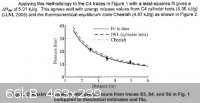
[Edited on 11-5-2012 by Hennig Brand]
"A risk-free world is a very dull world, one from which we are apt to learn little of consequence." -Geerat Vermeij
|
|
|
Hennig Brand
International Hazard
    
Posts: 1284
Registered: 7-6-2009
Member Is Offline
Mood: No Mood
|
|
I apologize if some of what I wrote above is incorrect. I found this in the course notes for an engineering rock excavation course from the university
of Arizona. It seems to agree fairly well with what Maniak said. The problem I am having is, one not being all that familiar with the material but
also, finding that the terms are not necessarily always used in the same way (I think).
"MGE 415 – Rock Excavation 2004
2.3.2.6 Detonation Pressure
The detonation pressure is the maximum theoretical pressure achieved within
the reaction zone and measured at the C-J plane in a column of explosives.
The actual pressure achieved is somewhat less than this maximum due to
non-ideal loading conditions always present in practice and due to certain
explosive formulation. Most commercial explosives achieve pressures in the
range of 0.29 to 3.48 x 106 psi (2 to 24 GPa). Although detonation pressure
is related to the temperature of the reaction, a number of simplifying
formulas are available for estimating detonation pressure for granular
explosives based on detonation velocity and density, for example
(in English units):
P = 0.00337 ρ V2
where P is detonation pressure in psi,
ρ is density XXX
V is detonation velocity in fps.
2.3.2.7 Borehole Pressure
Borehole pressure is the maximum pressure exerted within the borehole
upon completion of the explosive reaction measured behind the C-J plane.
Such measurements cannot be made directly and are done during
underwater tests performed for energy and strength determinations. With
the use of hydrodynamic computer models, theoretical calculations of
borehole pressures are made. There is little agreement in the literature
regarding specific estimates of actual borehole pressures. In general,
pressures after detonation within the borehole are estimated to be less than
30% of the theoretical detonation pressure."
edit:
I did a little explosive testing today and took a few pictures. Here are 5 of the better pictures. The charge in the picture is 14g of ~1.43 g/cc, 16%
inerts plastique (using polybutene binder instead of PIB this time). In the final picture is included the disc from the bottom of the steel tubing (I
think), which was retrieved from 4 inches below the surface of the rocky ground. The target is as before, rectangular structural steel tubing. Tubing
sides are 1/8" thick.
It seems like the steel next to the explosive got pulverized and the steel disc is what was left of the bottom piece. The side of the disc facing out
in the picture was ground off, because I was trying to see if the disc was two discs welded together. I now think it was just the bottom piece,
because it has a seam that matches the bottom and no other pieces could be found.
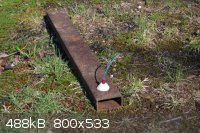 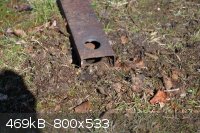 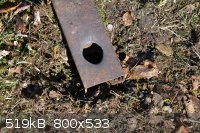 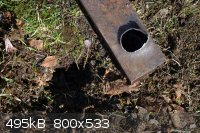 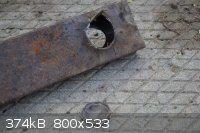
[Edited on 13-5-2012 by Hennig Brand]
"A risk-free world is a very dull world, one from which we are apt to learn little of consequence." -Geerat Vermeij
|
|
|
Hennig Brand
International Hazard
    
Posts: 1284
Registered: 7-6-2009
Member Is Offline
Mood: No Mood
|
|
Here is a measured value for the density of ETN, taken from the following journal, which should be very close to the actual value.
"Characterization and Analysis of Tetranitrate Esters"
Jimmie C. Oxley, James L. Smith, Joseph E. Brady IV, and Austin C. Brown
Pycnometer Density of ETN = 1.7219 g/cc
They also did PETN and got a value of 1.7599 g/cc, which is fairly close to the value of 1.77 g/cc I have seen in several other sources.
Drop weight/impact sensitivity testing was also done. I was a little surprised at their results.
Using a 4 kg fall hammer:
ETN = 24.0 cm
PETN = 25.2 cm
"A risk-free world is a very dull world, one from which we are apt to learn little of consequence." -Geerat Vermeij
|
|
|
Hennig Brand
International Hazard
    
Posts: 1284
Registered: 7-6-2009
Member Is Offline
Mood: No Mood
|
|
Just for fun, and a bit of affirmation, I initiated 13.5g of the same 81-82% ETN plastique, twice, using caps made of all the same materials. The
difference between the tests was that for the first test the PETN base charge was hand pressed as hard as could be comfortably done and for the second
test the PETN base charge was pressed much harder using a simple lever press.
The caps were 3/16" id aluminum tubing with about 25-27 thousands of an inch wall thickness. The base charges were 0.5g of PETN, initiated by 0.1g
lead azide and a bit of basic lead picrate as flash igniter. Black powder, core burning, fuse was used for delay and ignition. The target was
structural steel tubing with 1/8" wall thickness.
What a difference! The hole on the left is from the first test. The first test resulted in a larger top hole with a lot of tearing, but the hole on
the bottom side was much smaller. The explosion from the first also sounded much more impressive; the second explosion was a much sharper crack rather
than a huge boom like the first (at least that is how it was perceived by me and two others). Because of the greater roar, and the tearing, the two
others thought that meant that the first explosion was much more powerful than the second. The second explosion obviously had much higher velocity and
power. The explosion was a very sharp snap, which cut out nearly a perfect hole, on both sides of the tubing. The holes top and bottom where also of
nearly the same size, while in the first test the bottom hole was significantly smaller than the top.
The hole on the left is from the first test (hand pressed base charge). The hole on the right is from the second test (lever pressed base charge). The
last picture is of the bottom of the target.
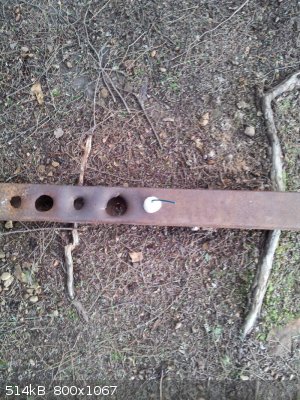 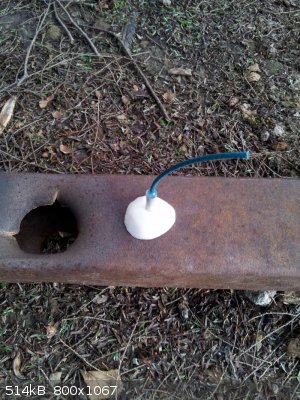 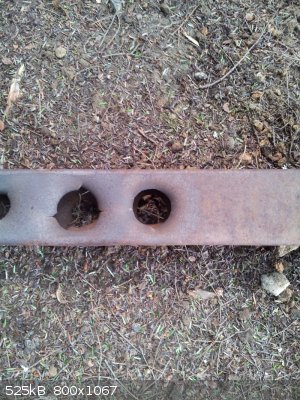 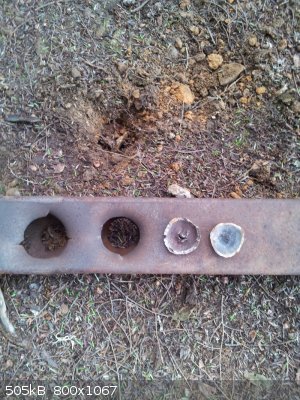 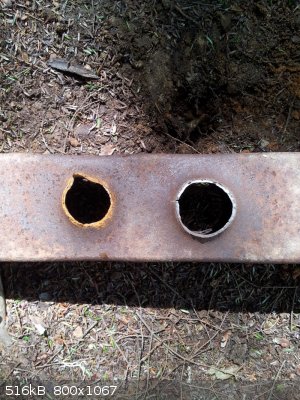
[Edited on 18-8-2014 by Hennig Brand]
"A risk-free world is a very dull world, one from which we are apt to learn little of consequence." -Geerat Vermeij
|
|
|
Vpatent357
Harmless

Posts: 22
Registered: 10-7-2014
Member Is Offline
Mood: No Mood
|
|
Good demonstration, yes the charge pressed by lever is obviously more powerful 
What kind of press and how you pressing your blasting caps?
Small blasting caps, fingers safe!
|
|
|
Hennig Brand
International Hazard
    
Posts: 1284
Registered: 7-6-2009
Member Is Offline
Mood: No Mood
|
|
You can find pictures, and a description, of the press used in the DDNP thread.
"A risk-free world is a very dull world, one from which we are apt to learn little of consequence." -Geerat Vermeij
|
|
|
Gargamel
Hazard to Others
  
Posts: 166
Registered: 9-3-2013
Member Is Offline
Mood: No Mood
|
|
Your reports are really good. A very valuable contribution.
Say, did you measure the density of both PETN base charges?
I'm disappointed by this plastique stuff. I would have imagined it reach it's full velocity itself once it starts to detonate. This shows that well
made blasting caps are really needed for serious experimentation...
|
|
|
Hennig Brand
International Hazard
    
Posts: 1284
Registered: 7-6-2009
Member Is Offline
Mood: No Mood
|
|
Thanks for the compliment. I didn't measure the density because it would have been difficult to do accurately with the equipment I had on hand,
especially since the cap and the base charge were so small. This was a crude test, but still a very useful one. The best way to measure loading
density is probably to have a way of accurately measuring loading pressure and from there density can be found since density is directly related to
loading pressure. There are tables for loading density versus loading pressure for various solid explosives which can be easily found in many
explosives texts.
"A risk-free world is a very dull world, one from which we are apt to learn little of consequence." -Geerat Vermeij
|
|
|
roXefeller
Hazard to Others
  
Posts: 463
Registered: 9-9-2013
Location: 13 Colonies
Member Is Offline
Mood: 220 221 whatever it takes
|
|
I had suspected that the granulated product would need some stout pressing to make it dense and cohesive. Wasn't it suggested to measure the
plastique density by putting a gram into an oral syringe and pressing it by hand? The syringes that come with my kids' medicine are up to 5mL though
I've seen some that are 2.5mL , so a gram should fall somewhere between 0.5 and 1mL.
|
|
|
Hennig Brand
International Hazard
    
Posts: 1284
Registered: 7-6-2009
Member Is Offline
Mood: No Mood
|
|
The syringe idea would probably work, but it would likely be very difficult to retrieve all the plastique after measuring. The syringe should be
reasonably accurate, if it is medical grade, but lack of accurate scales is a problem for many (especially with small masses). I used a polypropylene
pill bottle of carefully measured volume to measure the volume of a fairly large amount of plastique a while back and it was very difficult to
retrieve it all from the container (very sticky). Maybe we could use the displacement method Archimedes used to measure the density of the king's gold
crown. Plastiques are generally quite resistant to water, and the exposure could be very brief. Fill a suitable container to the brim, and then
carefully submerge the pre-weighed plastic explosive while carefully collect the overflow. The volume of the overflow should be the same as the volume
of the plastic explosive, if done carefully. Or simply submerge the plastique in a suitable graduated vessel containing enough water and measure the
volume increase. Then simply divide mass by volume to find the density of the plastique.
I believe he was talking about PETN base charge density in the blasting cap. I haven't had many problems forming cohesive masses of plastique. A glass
beer bottle is normally used as a rolling pin and with the right amount of softener/plasticizer, and once all the particles have a coating of binder,
the material sticks together quite well. I usually use about 15% inerts though. If I went much lower on inerts I would have difficulties with
cohesiveness given the low molecular weight of the binders available to me and the less than perfectly prepared explosive crystal size and shape. This
time I went a little over board on plasticizer, because I wasn't paying attention which resulted in a sticky, oily plastique of only 81-82% solid
explosive content.
I suppose I could get a fairly good approximation of base charge density by using the depth probe on a set of Vernier calipers. This could be
reasonably accurate if the calipers are decent quality, the bottom of the cap is flat, the loading pin has a flat end and the cap casing diameter is
uniform.
[Edited on 19-8-2014 by Hennig Brand]
"A risk-free world is a very dull world, one from which we are apt to learn little of consequence." -Geerat Vermeij
|
|
|
nitro-genes
International Hazard
    
Posts: 1048
Registered: 5-4-2005
Member Is Offline
|
|
Just noticed this thread, nice results! Have you tried the silicon oil as plasiticzer with the PiB/PB? Does it form a clear mixture when dissolved in
gasoline + binder? Depending on the source of the binder/MW etc, I noticed even with MR you can get some clouding/emulsification when too much is
added upon evaporation, with extra motoroil, this doesnt occur anymore.
The eureka method for determining density was what I used as well. For best results, take a long narrow graduate cylinder, add a small predetermined
measure of water. Then roll the plastique to a sausage of the same diameter. This way you only need as little water as possible, so youre mostly
measuring the volume change due to the plastique. If done a couple of times, you can get a really good estimate down to two decimal numbers. :-)
[Edited on 25-8-2014 by nitro-genes]
|
|
|
Hennig Brand
International Hazard
    
Posts: 1284
Registered: 7-6-2009
Member Is Offline
Mood: No Mood
|
|
I have actually been using polybutenes for quite a while which requires that no solvent be used at all. I also found, as Maniak suggested earlier in
this thread, that mineral oil works quite well to plasticize polybutenes. The softener/plasticizer can be added to the binder before adding the solid
explosive. A little careful heating can also be used to make the mixing process easier. The reason this works so well without solvent is likely
because of the low molecular weight of the polybutenes used, but it still makes a nice plastique if enough binder is used. I have tried silicone oil
with PIB and PB and it made a very nice plastique. Silicone oil also has extremely low vapor pressure (varies but always low), and is extremely inert,
which are real pluses.
I noticed the same thing with the MR and clouding, thanks for the tip. Sounds like a good method for measuring plastique volume also.
"A risk-free world is a very dull world, one from which we are apt to learn little of consequence." -Geerat Vermeij
|
|
|
NeonPulse
Hazard to Others
  
Posts: 417
Registered: 29-6-2013
Location: The other end of the internet.
Member Is Offline
Mood: Isolated from Reality! For Real this time....
|
|
I thought the solvent was to give an even coating to all the explosive before the rolling. How much extra work is involved without using solvent? I
guess that you would have to add the powder a little at a time to ensure the mixture uses it well without pockets of unmixed binder before adding the
next portion. I also noticed the clouding of the MR too but I don't believe it to have any adverse effects on the process so I pretty much ignored it
I. also found that using a light oil like "singer" sewing machine oil worked a little better than motor oil for me as I couldn't get motor oil without
the added detergents. I would like to test silicon oil or paraffin oil in fact there is quite a few id like to test but since they all would work
pretty well there's no real need to. I'm pretty happy with the results I'm getting now.
|
|
|
| Pages:
1
2
3
4
5
6 |